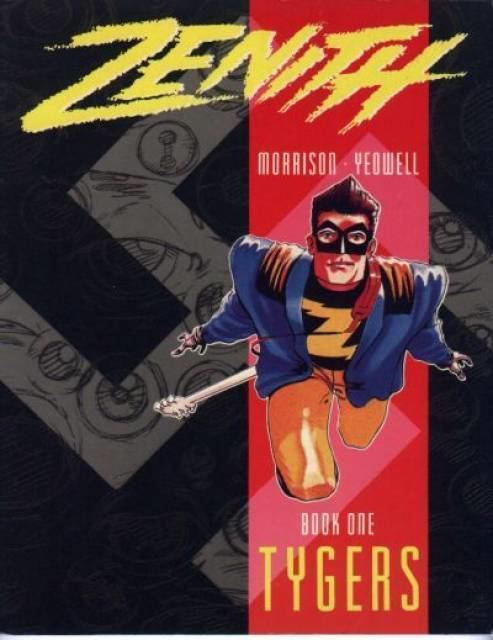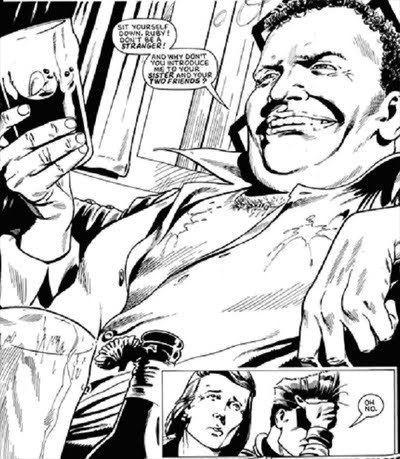Schedule Weekly | ||
 | ||
Created by Grant MorrisonBrendan McCarthySteve Yeowell Full name Robert Neal Cassady McDowell Formats Original material for the series has been published as a strip in the comics anthology(s) 2000 AD. Similar Sebastian O, Gideon Stargrave, Tharg the Mighty, Flex Mentallo, We3 | ||
Zenith was a story about a British superhero, which appeared in the British science fiction comic 2000 AD. Created by writer Grant Morrison and artist Steve Yeowell, with original character designs by Brendan McCarthy, it first appeared in 2000 AD #535 (22 August 1987). The character Zenith (real name Robert McDowell) first appeared in the second episode - the first episode set the backdrop for his introduction.
Contents

Shallow and sarcastic, Zenith was a distinctly Generation X superhero. Morrison used the Zenith serial to explore cultural differences between generations and criticise the Conservative Party.

Zenith was featured regularly in 2000 AD from 1987 until 1992, with occasional appearances since. The series was an early success for Morrison, who has since written popular works for DC and Marvel, using his own characters.

Publication history

Zenith appeared in August 1987 during a period when editor and assistant editor, Steve MacManus and Richard Burton respectively, were shaking up 2000 AD by publishing numerous new stories which gave fresh talent a chance. Grant Morrison had been thinking along the lines of Zenith since 1982, but "[t]he original version had a more traditional superhero costume and was a little grimmer in tone," and the final concept came together as "... a reaction against torment superheroes." Despite liking both Dark Knight and Watchmen, he felt that "... both books felt pompous and concept albumy to me as a young man in the '80s." He found more of an influence in the work of Brendan McCarthy: "... tell the truth on to the page and let your psyche all hang out," and it was McCarthy who would provide the initial character designs, although he never drew the actual story, because Morrison said "... the story as it unfolded would have been too ponderous and long-winded for him."

With hindsight, Morrison stated, "I like Phase I the least now –- it wears its influences a little too obviously on its sleeve." He rated Phase III far higher, saying, "I think it is one of the greatest superhero crossover events ever."
In America, Zenith Phases I and II were reprinted in colour in Fleetway/Quality's monthly 2000 A.D. Showcase title, beginning in the jointly-numbered issue 29/30, and running through issue 45 (September 1988-December 1989). These issues featured new covers by American comic book artists such as Jackson Guice, Tom Lyle, and Bart Sears. According to the series' index at the Grand Comics Database, "The end of the Phase II storyline was also the end of the Zenith reprints, as Phase III was still in progress in the British weekly. It ended in March of 1990, but by that time this magazine was about to be cancelled."
Zenith returned for Phase IV in 1992 but Morrison's attention was elsewhere: "I'd moved on and was more excited by the possibilities of working with American superheroes. By 1992, Zenith seemed like something dragged up from my past." However, that does not mean he thinks any less of the story: "I like a lot of things I write under duress. I actually really like the last book of Zenith. I'm very fond of it."
Titan Books published five trade paperbacks of Zenith between 1988 and 1990, collecting Phase I through III. However for years after that, attempts to re-publish the series (including the never collected Phase IV) were prevented by a copyright dispute between the publisher and Morrison. In 2007, Morrison said, "Fleetway have no paperwork to confirm their ownership of Zenith, so I'm currently involved in legal proceedings to clear things up."
On 29 May 2013, British publishing company Rebellion Developments announced that they were publishing a complete collection as a hardcover book limited to 1000 copies. The book sold out within two days of being announced and the delivery date was brought forward to early October. The book collected all four phases and has a nearly exhaustive collection of covers and pin-ups. Whilst parties involved in ongoing legal proceedings are, as a rule, barred from speaking publicly of them, it appears that Morrison has been unsuccessful in halting that initial publication. Zenith Books 1 and 2 could be pre-ordered for a December 2014 launch through mainstream distribution chains.
Plot
Robert McDowell, alias Zenith, was the son of two members of Cloud 9, a super-team of the 1960s assembled by the British military who had rebelled and become hippies and psychedelic fashion icons. Zenith himself used his Biorhythm dependant super-human abilities, not to fight evil, but to promote his career as a pop singer. Shallow, spoilt, self-centred and initially cowardly, he was reluctantly dragged into the struggle against malevolent, supernatural entities known as the Lloigor or "Many-Angled Ones".
The British superhuman project "Maximan" had emerged from work brought over by defecting Nazi scientists in World War II, in turn, having been developed from knowledge obtained from the Lloigor. The Nazis had created "Masterman", but in fact, the real purpose of the project was to produce host bodies strong enough to house the Lloigor's spirits. Due to those circumstances, within the story's alternate history, Berlin was the target of the first nuclear weapon, not Hiroshima or Nagasaki, mainly because both the British and Nazi supermen were fighting in Berlin at the time.
The British superheroes came of age during the tumultuous '60s, and promptly rebelled, as did many teens of that time. Ultimately, Zenith's parents were killed, (by American psychic agents - although that is not revealed until later in the storyline,) other members of Cloud 9 disappeared, and the few remaining lost their powers and retreated into civilian life: Peter St. John, (Mandala) became a Member of Parliament for the Conservative Party, and Ruby Fox (Voltage), a journalist and writer. Siadwell Rhys (Red Dragon) owned a pub in Wales - where he apparently spent much of his time drunk.
Zenith since returned three times to the pages of 2000 AD: In zzzenith.com, a one-off featured in "Prog 2001" set years after the end of the previous series. Zenith once again met with St John, who was still in control of the country via a telepathically-manipulated Tony Blair. Zenith, being aware of that, was not particularly bothered, and therefore, St John seemed equally unconcerned by Zenith's knowledge of the truth. St John was still in possession of the Omnihedron pocket universe containing the Lloigor, however Marconi had been experimenting with it, and St John was worried about the results gained.
Zenith also appeared in a story unconnected to the Zenith universe – A Night 2 Remember, a strip about the comic's 25th anniversary celebrations, which appeared in Prog 1280. His final appearance so far is on the cover of Prog 1500, although his image is small and hard to see.
Collected editions
Zenith was printed as a series of (out of print) trade paperbacks by Titan Books. However, on 29 May 2013, 2000 AD publishers Rebellion announced plans to re-print the entire series in a hardcover volume, limited to 1,000 copies. Priced at £100, the book was published on 1 December 2013, and sold exclusively via their website. A series of cheaper books began in 2014.
